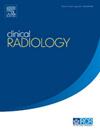电视胸腔镜手术前CT引导定位肺毛玻璃结节血管迷走神经反应的发生率及影响因素
IF 2.1
3区 医学
Q2 RADIOLOGY, NUCLEAR MEDICINE & MEDICAL IMAGING
引用次数: 0
摘要
目的探讨电视胸腔镜手术(VATS)前CT引导下肺磨玻璃结节(GGNs)定位时血管迷走神经反应(VVR)的发生率、临床特征及影响因素。材料与方法选择连续1303例行ct引导下ggn定位的患者作为研究对象。与ct引导定位相关的VVR定义为定位期间或之后出现无法解释的短暂性低血压和/或相对心动过缓,表现为苍白、出汗、恶心和潜在晕厥等症状。通过单因素和多因素分析确定VVR的危险因素。结果4.5%(58/ 1303)的患者出现vvr。所有的vvr都发生在定位后,91.4%(53/58)的vvr发生在患者从CT台起身到离开CT室之间。所有VVR病例的前驱症状都很明显,其中两例进展为晕厥,每例都有短暂的意识丧失,持续时间不到一分钟。单因素分析确定了VVR的重要危险因素,包括患者年龄、应激水平、晕厥史、多个ggn标记以及标记时间。多因素logistic回归分析显示,患者应激(优势比[OR], 20.17;P & lt;0.001)和晕厥史(OR, 8.06;P = 0.002)是VVR的独立危险因素。结论在接受CT引导下ggn定位的患者中,vvr影响了约4.5%的患者,通常在从CT表上升后立即表现出来。患者的压力和晕厥史与VVR的可能性增加显著相关。本文章由计算机程序翻译,如有差异,请以英文原文为准。
Incidence and influencing factors of vasovagal reaction in computed tomography (CT)-guided localisation of pulmonary ground-glass nodules prior to video-assisted thoracoscopic surgery
Aim
To investigate the incidence, clinical features, and influencing factors of vasovagal reaction (VVR) associated with computed tomography (CT)-guided localisation of pulmonary ground-glass nodules (GGNs) prior to video-assisted thoracoscopic surgery (VATS).
Materials and methods
A total of 1303 consecutive patients who underwent CT-guided localisation of GGNs were selected as research subjects. VVR related to CT-guided localisation was defined as the onset of otherwise unexplained transient hypotension and/or relative bradycardia during or after localisation, manifesting as symptoms such as pallor, sweating, nausea, and potentially syncope. Risk factors for VVR were identified through both univariate and multivariate analyses.
Results
VVR was observed in 4.5% (58/1,303) of the patients. All VVRs occurred postlocalisation, with 91.4% (53/58) happening between the time patients rose from the CT table and their departure from the CT room. Prodromal symptoms were evident in all VVR cases, with two cases progressing to syncope, each with a brief loss of consciousness lasting less than one minute. Univariate analysis identified significant risk factors for VVR, including patient age, stress level, history of syncope, and the marking of multiple GGNs, as well as marking time. Multivariate logistic regression analysis revealed that patient stress (odds ratio [OR], 20.17; P < 0.001) and a history of syncope (OR, 8.06; P = 0.002) were independent risk factors for VVR.
Conclusion
VVR affects approximately 4.5% of patients undergoing CT-guided localisation of GGNs, often manifesting immediately after rising from the CT table. Patient stress and a history of syncope are significantly associated with an increased likelihood of VVR.
求助全文
通过发布文献求助,成功后即可免费获取论文全文。
去求助
来源期刊

Clinical radiology
医学-核医学
CiteScore
4.70
自引率
3.80%
发文量
528
审稿时长
76 days
期刊介绍:
Clinical Radiology is published by Elsevier on behalf of The Royal College of Radiologists. Clinical Radiology is an International Journal bringing you original research, editorials and review articles on all aspects of diagnostic imaging, including:
• Computed tomography
• Magnetic resonance imaging
• Ultrasonography
• Digital radiology
• Interventional radiology
• Radiography
• Nuclear medicine
Papers on radiological protection, quality assurance, audit in radiology and matters relating to radiological training and education are also included. In addition, each issue contains correspondence, book reviews and notices of forthcoming events.
 求助内容:
求助内容: 应助结果提醒方式:
应助结果提醒方式:


